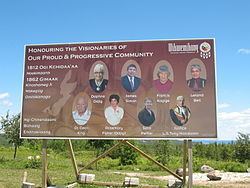Country Canada First Nation Wikwemikong Postal code span P0P 2J0 Population 2,592 (2011) Local time Sunday 6:19 PM | District Manitoulin Time zone EST (UTC-5) Website www.wikwemikong.ca Province Ontario Area code 705 | |
 | ||
Weather 8°C, Wind S at 8 km/h, 53% Humidity | ||
The Wikwemikong First Nation is a First Nation on Manitoulin Island in northern Ontario. The Wikwemikong Unceded Reserve (also called Wikwemikong, Wiikwemkoong, or simply Wiky) is their First Nation reserve in the north-eastern section of Manitoulin Island in Manitoulin District, Ontario, Canada. Wikwemikong is an unceded Indian reserve in Canada, which means that it has not "relinquished title to its land to the government by treaty or otherwise."
Contents
- Map of Wikwemikong ON Canada
- Wikwemikong first nation with candy palmater
- Geography
- History
- Communities
- Transportation
- Culture
- People
- References
Map of Wikwemikong, ON, Canada
The local Ojibwe placename is wiikwemkong (Manitoulin dialect; notice the vowel dropping) with the locative -ong (‘at’) form of wiikwemik ‘bay with a gently sloping bottom’. The spelling Wikwemikong is from dialects spoken elsewhere (or in earlier times) that retain the i. The initial element wiikwe- occurs in other forms as ‘bay’; the final element -mik cannot be for amik ‘beaver’ (local form there mik), a folk-etymology that violates the rules for Algonquian stem formation. It can be identified as a variant of the medial element aamik- that appears, for example, in Southwestern Ojibwe minaamikaa ‘there are breakers, shoals, banks (of sand or rocks)’, which has initial min- ‘islandlike’. The plus or minus of aa- is found in several medial elements in Ojibwe and other Algonquian languages.
The reserve's former name was Manitoulin Unceded Indian Reserve; the Wikwemikong Band changed it on August 20, 1968, to Wikwemikong Unceded Indian Reserve.
The reserve is occupied by Ojibwa, Odawa and Potawatomi peoples, under the Council of Three Fires. The current band chief is Duke Peltier.
Wikwemikong first nation with candy palmater
Geography
Wikwemikong occupies a large peninsula on the eastern end of Manitoulin Island, which is connected to the rest of the island by an isthmus separating South Bay from Manitowaning Bay. The reserve's primary access is via Wikwemikong Way, which continues off the reserve as Cardwell Street and connects to Highway 6 at Manitowaning. The reserve has a land area of 412.97 km² and is the fifth-largest Indian reserve in Canada by area. It is bordered on its west by Assiginack township, by which the peninsula is connected to the rest of Manitoulin Island. The vast majority of the reserve's border is, however, a water boundary with Northeastern Manitoulin and the Islands, by which it is nearly surrounded except for its border with Assiginack.
The smaller Point Grondine 3 reserve, located on the mainland near Killarney, also belongs to the Wikwemikong band.
History
From 1836 to 1862, a considerable portion of Manitoulin Island was set aside as the "Manitoulin Island Indian Reserve" under the Bond Head Treaty. The most important of the pre-confederation treaties were the Robinson Treaties because all subsequent treaties were modeled after these. In 1850, William B. Robinson, a government negotiator and former fur trader, proposed that First Nations reserves be created on the Crown Land acquired through treaties. These Reserves were intended to be the answer to what the immigrant settlers needed for land settlement. First Nation peoples would be set apart on reserves from the new settlers. The Robinson-Huron and Robinson-Superior treaties were signed in September 1850 for large territories north of the two Great Lakes.
According to written records, Lake Huron and Lake Superior area leaders surrendered nearly 15 000 000 hectares of land and the islands in exchange for the establishment of 24 reserves and a payment of approximately $10 000 to be followed by additional annual payment of $2700.
In 1862, most of the islands were again ceded to the government of Canada under the MacDougall Treaty for new settlement by non-natives, resulting in the creation of new reserves at West Bay, Sheguiandah, Sheshegwaning, Cockburn Island and Sucker Creek. However, two bands which occupied the land that now comprises Wikwemikong claimed that the bands that signed the Treaty did not represent them, and thus continued to exist as a remnant of the Manitoulin Island Indian Reserve.
Wikwemikong as it exists today was created in 1968, when the two unceded bands and the ceded Point Grondine band amalgamated as the Wikwemikong band. Point Grondine was created as Reserve #3 in the Robinson Huron Treaty of 1850.
Communities
In addition to the primary settlement at Wikwemikong, smaller settlements on the reserve include Buzwah, Kaboni, Murray Hill, South Bay, Two O'Clock, Wabozominissing and Wikwemikonsing.
The reserve is served by four churches:
There are two elementary school, Wasse Abin Junior School (JK, SK, Grades 1-4) and Wasse Abin Pontiac School (Grades 5-8) and Wasse Abin High School.
Two health clinics provide basic services:
Transportation
Wikwemikong Way is the key route in the communities and connects with Ontario Highway 6.
The closest airport is Manitowaning/Manitoulin East Municipal Airport in Manitowaning, Ontario.
Culture
The reserve is also home to the Wikwemikong Cultural Festival (Wikwemikong Pow-Wow) which is held annually every Civic Holiday weekend (first weekend in August).
This annual event is touted as the largest and oldest pow-wow in Eastern Canada. Considered to be one of the major pow wows in North America, it is attended by many aboriginal dancers who participate in competition of all age ranges, demonstrating traditional, grass, jingle and fancy dancing.
Wikwemikong is also home to a professional theatre company, De-ba-jeh-mu-jig Theatre Group, which stages and produces plays about First Nations life and culture, within the missions ruins next to Holy Cross Church.
People
Notable people from Wikwemikong include indigenous women's rights advocate Jeanette Corbiere Lavell, country music artist Crystal Shawanda, Federal Court of Canada judge Leonard S. Mandamin, former NHL player Chris Simon and artist Daphne Odjig.
